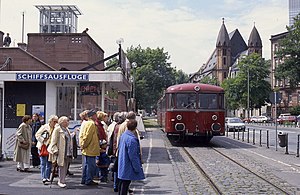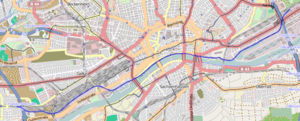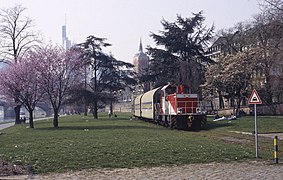Municipal connection line Frankfurt am Main
| Municipal connection line Frankfurt am Main | |
|---|---|
|
Rail bus on the connecting line at Eiserner Steg
| |
|
Course of the connecting track
| |
| Route number (DB) : | 3626 |
| Course book section (DB) : | - |
| Route length: | 7.9 km |
| Gauge : | 1435 mm ( standard gauge ) |
The urban connection line (in short: connection line ) is a railway infrastructure owned by the city of Frankfurt am Main and an essential part of the Frankfurt port railway .
prehistory
The first railways to reach Frankfurt am Main (the Taunus-Eisenbahn , the Main-Neckar-Bahn , the Main-Weser-Bahn and the Hanauer-Bahn ) each ended in their own terminal stations on the outskirts of the city - the first three lines mentioned in the Frankfurt West train stations , the Hanau railway in the east of the city. The transport policy of the Free City of Frankfurt was initially based on a historically outdated concept, namely not to promote the connection of the railways between East and West, but to promote the economy of the city analogous to a stacking law by the goods had to be reloaded here. As a result, the non- stop transport of goods and people was only possible after two reloading or changing trains, and this put a heavy burden on the volume of traffic in the city. In addition, this policy exposed the city to the risk of being sidelined as soon as end-to-end rail links capable of providing this west-east transport service started operating in neighboring states.
In 1854, the Bavarian Ludwigs-West-Bahn was connected to the Hanauer Bahn, which became a long-distance line and the volume of traffic increased accordingly. This increased the burden on inner-city traffic in Frankfurt. In 1858, operations on the Rhine-Main Railway of the Hessian Ludwig Railway Company (HLB) began in the neighboring Grand Duchy of Hesse . The route led from Mainz via Darmstadt to Aschaffenburg and thus performed precisely the long-distance traffic that Frankfurt had previously refused.
In order not to get sidelined, the Free City of Frankfurt now had to create its own connection between the Hanau train station and the western train stations. This happened with the connecting railway.
history
On July 31, 1859, the then approximately six kilometers long stretch, which largely runs along the northern bank of the Main , was opened to traffic. The Frankfurt-Hanauer Eisenbahn-Gesellschaft (FHE) initially ran the company . After management had already passed to the Hessische Ludwigsbahn in 1863 , the FHE finally took over completely in 1872.
After the annexation of the Free City of Frankfurt by the Kingdom of Prussia in 1866 as a result of the Prussian-Austrian War , the connecting line remained in municipal ownership - in contrast to the Frankfurt shares in the two condominal lines Main-Neckar- and Main-Weser-Bahn.
Until June 1, 1869, only goods traffic took place on the route . After the Frankfurt-Bebra Railway was completed by the Prussian State Railway at the end of 1868 , but the Steinheim Main Bridge near Hanau had not yet been completed, traffic on this route was continued via the connecting railway to the western railway stations. This meant that passenger trains, including express trains, also ran here for the first time. This traffic ended in 1873 when the Steinheim Main Bridge went into operation and the Frankfurt-Bebraer Railway now ran on the left bank of the Main and was directed via the Bebraer Bahnhof (today: Frankfurt (Main) Süd ) to the Westbahnhöfe.
In 1880 the connecting line was extended by 1.7 kilometers to the west and was thus connected to the Main-Lahn-Bahn . This was operated by the Hessian Ludwig Railway since 1877, which ran between Limburg an der Lahn and Frankfurt's western train stations. The HLB thus had a continuous infrastructure from the Main-Lahn-Bahn via the connecting line to the Hanauer Bahn. The Hessian Ludwig Railway used this to allow through trains to run also for passenger traffic. The Frankfurt (Main) Fahrtor stop was set up for this purpose in the inner-city area . The operational problem was that the Hanau station in Frankfurt could only be reached by such trains with a saw drive .
On April 1, 1897, the HLB was nationalized and thereby part of the Prussian-Hessian Railway Operating and Financial Community . Passenger traffic initially continued, but ended on April 1, 1913, when the Frankfurt – Hanau railway was connected to the south station via the newly built Ostbahnhof via the Deutschherrnbrücke . At the same time, with the opening of the Frankfurt Osthafen in 1913 , the connecting railway increased in importance as the Frankfurt port railway.
The city of Frankfurt founded as Eigenbetrieb the Urban Hafenbahn as rail infrastructure and rail transport companies . Its importance for the newly emerging port facilities, industrial areas on Hanauer Landstrasse and the wholesale market hall grew steadily until the Second World War , which caused considerable damage to the facilities due to the air raids on Frankfurt am Main .
When all the railway bridges over the Main were destroyed after the end of the war in 1945, the connecting line regained importance for regional traffic: It was the only usable railway connection between the western and eastern tracks of the city. This is how modest passenger traffic came about again: the small train Frankfurt – Königstein ran its trains from July 13th to September 30th, 1945 from the Taunus via the stations Frankfurt-Höchst , Fahrtor , Großmarkthalle and Riederhöfe to the Frankfurt-Mainkur station .
Today's meaning
Special train of the HEF at the Eiserner Steg
Today, on weekdays, the connecting railway has handover journeys for the port railway in freight traffic and occasionally in passenger traffic with historical special trains operated by the Frankfurt Historical Railway (HEF) .
The port railway operated by HFM Managementgesellschaft für Hafen und Markt mbH has a track network of 52 kilometers, 30 employees and three Krauss-Maffei MH 05 Diesel locomotives , which were used to transport 728,609 tons of goods in 2017. The Frankfurt am Main-Ost freight yard and the Frankfurt am Main-Griesheim transfer station serve as interfaces to the rail network of Deutsche Bahn . The port railway has an operations workshop for vehicle maintenance and upkeep with two tracks with a usable length of 43 meters each. In the area of rail logistics, in addition to classic services such as block train transport, inland port transport and freight wagon scheduling, it also offers other services, such as wagon maintenance and wagon inspection services, rental of diesel locomotives and the provision of personnel in shunting services.
In the course of the redesign of the area of the former wholesale market hall and the new building of the European Central Bank as well as the design of the remaining areas as public areas, the main track of the connecting railway between the loading cranes, which have been preserved as a monument, and the Honsell Bridge was re-routed. In addition, pitfalls for vehicles were built on the eastern and western borders of the safety area to prevent them from entering the safety area. Furthermore, the old track in Lindleystraße was abandoned and instead one of the tracks directly on the north basin quay of the east port between Honsellbrücke and Schwedlersee was renovated. In April 2015, the stopping point at the ECB was added for passenger trains.
Web links
Individual evidence
- ↑ DB Netze - Infrastructure Register
- ↑ Railway Atlas Germany . 9th edition. Schweers + Wall, Aachen 2014, ISBN 978-3-89494-145-1 .
- ↑ A copy of a corresponding timetable was on view in the exhibition 150 Years of the Port Railway on July 11 and 12, 2009 in the Osthafen station .
- ↑ Railway logistics service accessed on March 6, 2019
- ↑ Info flyer service offer accessed on March 6, 2019
- ↑ Marvin Christ, Wilfried Staub: Newsletter of the Historical Railway Frankfurt (HEF) No. 75 . Ed .: Historical Railway Frankfurt e. V. Frankfurt May 13, 2015, p. 5-6 .








